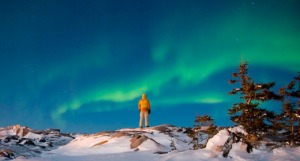
When my wife told me we were moving to the Arctic Circle, I knew we didn’t have what we’d need to survive up there. I figured we would be spending a bit of money on boots and gloves and a few other things. Boy, oh boy, was I wrong! Boots are the tip of the iceberg. Like the snowball rolling down the mountainside, outfitting ourselves to stay warm in the harsh winter kept getting bigger and bigger.
So I set out to research every single bit of gear that’s required for living in temperatures that drop downwards of -75 degrees Fahrenheit in the cold, dark winter months. The keyword when preparing for the harsh extreme cold is: layers. Some of my readers may think they know what cold feels like in New York, Winnepeg, or Minnesota – you don’t. Trust me; as I write this article, the temperature outside is in the 20s and it’s only September!
Shopping for winter coats and parkas for a normal winter in the Lower 48 is easy! E – A – S – Y! Not all stores carry the quality gear we need in Alaska, not all companies even make said gear. But I don’t want to get ahead of myself. I’ll start at the beginning (or the bottom, and work my way up).
Boots
We felt the footwear was the most important, so that’s where we started. While you can layer your feet, for the most part boots need to have all the characteristics of successful outer and inner layers, meaning: warmth and waterproof. Knee–high boots are good in the spring and fall because you might be wading through deep mud puddles; that also means they should be made of some heavy–duty rubber. In the winter, they don’t necessarily need to be that high, but a high, warm boot helps to keep your calves toasty too.
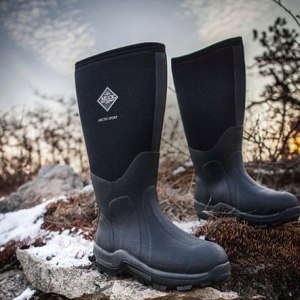
I decided to go with Muck brand boots; they have a line called Arctic Sport that is tested down to –40F. I also will be wearing wool socks underneath. The great thing about Mucks (as they’re called up here) is the versatility of the single pair of boots. I didn’t need to buy snow boots, rain boots, hiking boots, etc. One pair is a one-stop-shop.
Other guys swear by Baffins, or army-style ‘bunny‘ boots, but they just didn’t come up high enough on my leg for the rainy season. They do look awesome though – I’d feel like a SWAT team member wearing them, so if the Mucks don’t work out for whatever reason, I can always get another pair down the road. If my wife lets me.
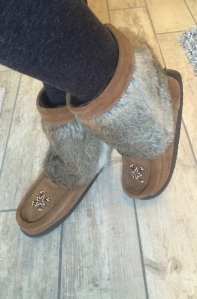
Jen went a different direction. She wanted traditional Native Alaskan Mukluks. Her opinion is that if it worked for the native population for thousands of years, it will work for her. She did some research and found a pair she liked from a Canadian company. They’re made of sueded leather (a different pair was actual moose-hide) with a rubber sole that’s glued to the bottom of the mukluk. They are lined both inside and out with rabbit fur. There’s even some cute bead work on the top of the foot. The problem is that mukluks aren’t a one-stop-shop like my Mucks are; if she gets the suede wet or muddy, the boots are destroyed. So we needed to get her an inexpensive pair of waterproof rain boots as well (though if the puddle’s deep enough, the suction will take the boot right off her foot). She also has wool socks.
Coats & Pants
No company makes a single piece of gear that withstands everything you’ll need in the subzero temperatures. There are plenty of websites that offer advice on how to layer properly. The problem is all the best gear for what we need has the highest price tags. When I called to speak to sales reps on the phone at the various clothing companies, they helped as best as they could, but without all the information, the brick wall hit us in the face.
Most of the time, the gear will be just to get us back and forth to school or the post office. We won’t be spending hours upon hours in the cold wind and frigid temperatures – but you never know. We want to be prepared for a day when we have to be out for hours. Maybe that’s not possible, we’ll see. A lot of guys tend to have multiple sets of gear for different purposes, but these men are ‘lifers‘ up here. We aren’t going to be. We just need some good quality gear to survive the next few winters.
My friend Glen – ex Army Ranger, retired science educator, and avid hunter & trapper – told me that each person has a different way of doing things in the cold; he said try it out and if it doesn’t work, change it. So we’re back to trial and error. And if we choose wrong, the situation can get deadly quickly. Hypothermia and Frostbite are household words up here.
Basically the way it works is like this: wool base layer (because it wicks up the moisture from your sweat), polar fleece mid–layer, heavy insulation layer (like goose down – but 500 fill coats aren’t enough, you need at least 750 fill for the Arctic), and then an outer layer called the ‘shell‘ that’s typically waterproof and windproof. The best is Gore–Tex.
A lot of people up here say that waterproof isn’t critical because we have dry winters. Essentially, once the temperature drops that far below the freezing point, the air no longer carries any moisture at all (remember those Arizonans talking about the dry heat of the desert not being as bad as the humidity in Florida?). I disagree though.
Suppose you’re traipsing through the snow for whatever reason and your body, or your movement heats up the snow enough that it begins to turn back to water. The last thing you want is to not have a waterproof shell, especially with down. The instant down gets wet, it’s worthless. It will get heavy and take a long time to dry. Wet down will not keep you warm. Waterproof shells are also windproof – and that is something that you’ll need up here as gusts of wind can make a –20F day feel like –40F in minutes.
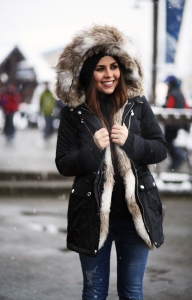
So Jen chose a coat by another Canadian company called Sorel, that has 800 fill goose and duck down. I also got us both sets of polar fleece mid-layers, merino wool base layers, and snow pants from a company called 6th Avenue Outfitters that by themselves aren’t enough, but with proper layering should be. And again, if none of this ends up working, it’s like playing roulette in Atlantic City. I guess we go back to the drawing board and keep buying stuff until we’re warm enough.
As far as my coat, I have a tri-climate Toread (Chinese brand) coat that I bought a couple years ago (tri-climate means the jacket is in pieces and can be upzipped into separate parts for various uses). The shell is in perfect condition, but the insulation layer that came with it, won’t cut it up here. I’ll need a new one at some point, but with all the money we’ve been spending on other layers, I’m going to give it a shot and see how warm the coat keeps me as-is. After all, like I said, I don’t know how much time I’ll be spending outside at all. I already run hot, so if I’m able to layer up correctly, the insulation layer might not be needed for quick 10 minute walks back and forth across the village.
Head & Hands
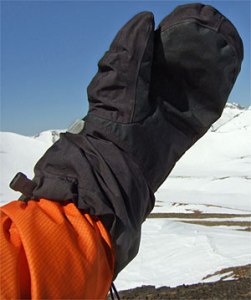
Similar to the rest of the body, you’ve got to layer your head and hands. Frostbite can occur on any patch of exposed skin within seconds. So you’ve got to make sure that every inch of your body is protected. On our hands we have layers mitts that begin with a merino wool liner, followed by an insulated and waterproof subzero tested mitten – warmer than gloves because keeping your fingers together traps in the heat.
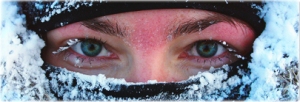
The head and neck are two of the most important parts of your body to keep warm. The warmth of your head affects your fingers and toes as well. You start with a full head/neck balaclava of wool or synthetic material. It pulls down to your chest and the only exposed skin at this point are your eyes and cheekbones. Then you put on a neck gaiter, typically fleece, and a beanie or wool sock cap on your head – these are your insulation layers. To protect your eyes, you need goggles. Finally, you can put the hood of your coat up, tie it snugly, and you’re ready to brave the elements.
For those of you keeping score, we have 1) socks 2) boots 3) outer shell legs 4) fleece mid-layer legs 5) wool base layer legs 6) outer shell coat 7) down insulation layer 8) fleece mid-layer 9) wool base layer 10) wool glove liners 11) waterproof mitts 12) neck gaiter 13) balaclava 14) wool cap 15) goggles. Over $1,000.00 in extreme winter gear, per person!
All of that just to go pick up the mail.
Until Next Time…
-Justin
And after all that, you’ll see the kids walking to school in jeans and sneakers at forty below. All that gear is great for when it gets super cold, and it’s absolutely necessary if you’re sitting still like you do on a long snowmachine ride, but I think you’ll find that into the twenties it’s easy to be comfortable, especially if you’re walking or skiing, in a couple layers of wool sweaters, a shell jacket (I use a cheap rain coat) and a good pair of carhartt arctic-weight overalls. Fur hats are really nice though. You can probably pick up some awesome ones in the village after a paycheck or two has replenished the coffers.
That’s twenties below, just to be clear. 😉
Nice job keeping us all up to date and in the loop.
I used to wear hoodies and flip flops in -20 degree weather, haha. You’ll get used to it. And it’s neat that you are going to Kotzebue, two of my adopted boys are from that tribe. 🙂